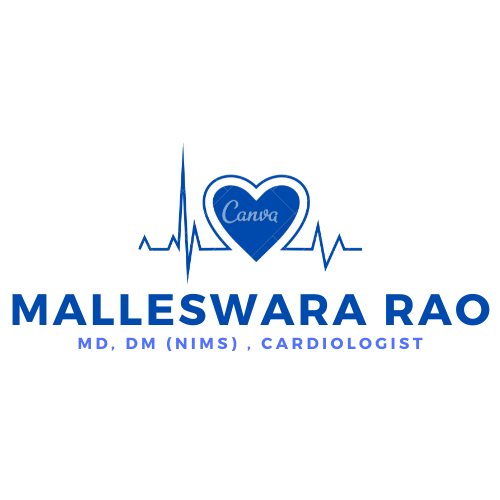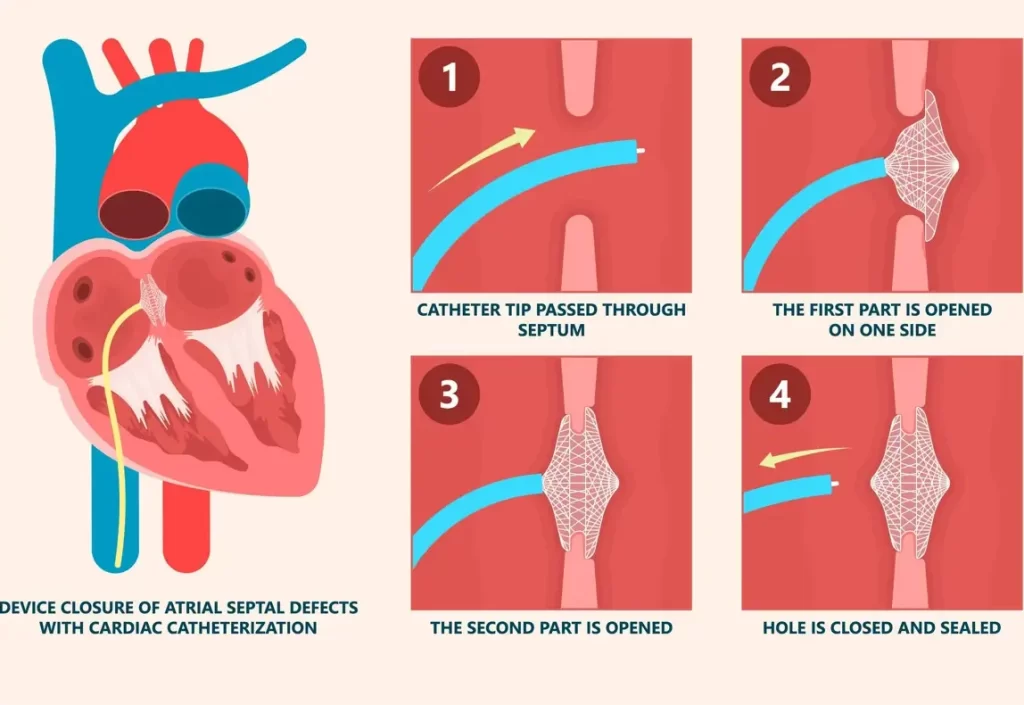ASD device closure full form: Atrial septal defect device closure
ASD device closure introduction:
A new development in heart care, device closure, has shown promising results in atrial septal defects (ASD) patients. These devices improve patient health and life expectancy while reducing treatment time and costs associated with open-heart surgery.
ASD devices have been developed and can be used to treat certain types of ASD without the need for open-heart surgery. This innovation has shown promising results and could improve the quality of life of children born with heart defects and reduce healthcare costs and recovery time. Device closure has been approved by the FDA and is currently available at major hospitals throughout India.
One of the most common congenital heart diseases is an atrial septal defect, a hole in the wall separating the heart’s upper left and right sides that creates a pathway for blood to flow from one side to the other. Cardiothoracic surgeons have been able to close up these holes using surgical instruments and patch the defect, but such surgeries are risky and have limited success rates. A cardiologist can close the hole with catheters and devices to access the heart with no scar.
Sealing Up Heart Defects: A Breakthrough in Cardiac Care
Here’s how the device works and why it’s poised to be the breakthrough in cardiac care.
Why Is This Important?
Open-heart surgery is a serious medical procedure, and with any major surgery comes a risk of infection and bleeding. Infections occur at a slightly higher rate than in other surgeries when it comes to heart surgery. These infections can be life-threatening and may cause lasting damage. Bleeding can be severe and may need a blood transfusion.
How Does the Device Work?
A device is an alternative to, or even a replacement for, open-heart surgery. Instead of operating on a child or adult with a heart defect and running them through open-heart surgery, doctors can insert a tube into their body and keep these implants in their heart-all without ever having to cut them open. The procedure requires a minimal hospital stay.
Device closure is not suitable for
- Primum ASD
- Sinus venosus ASDs
- Coronary sinus defects
- ASD with other cardiac anomalies
- Large ostium secundum ASD
- Ostium Secundum ASD with insufficient rims
- ASD with eisenmengerisation
- Multiple ASDs (can occasionally be closed by two devices)
For most patients with secundum ASDs, percutaneous transcatheter device closure provides a viable option for surgical treatment. Surgical closure is advised when device closure is not feasible or acceptable for patients with secundum ASD.
Large ASD device closure:
We try devices for ASD up to 38 mm with an amplatzer device. Closing a large ASD with a device needs technical expertise and special techniques. Device migration or embolization chances are higher compared to smaller ASD.
Device closure versus open surgery for ASD
- Mortality rates are similar.
- The procedural success rate is comparable to or slightly better than open-heart surgery.
- Early complications are less with the device
- Length of hospital stay is short with the device
- Major bleeding is common with open-heart surgery
Why do I need to close my ASD when I don’t have any symptoms?
After the bicuspid aortic valve, atrial septal defect (ASD) is the most common congenital lesion in adults. Although patients with ASD are frequently asymptomatic until adulthood, untreated ASDs can lead to severe problems, including death
- Atrial arrhythmias
- Bradycardia or heart block
- Paradoxical embolization
- Cerebral abscess
- Right ventricular failure
- Irreversible pulmonary hypertension
- Right-to-left shunting (Eisenmenger syndrome).
- Death
Tests before ASD device closure:
Transthoracic echocardiography (TTE) or 2d echo test: First line test to diagnose ASD
To confirm the diagnosis and identify or exclude related abnormalities; some patients require additional testing, such as
- Transesophageal echocardiography (TEE): look for device suitability and device size
- cardiovascular computed tomography (CT) or cardiac magnetic resonance (CMR) imaging: identify or exclude related abnormalities
- Cardiac catheterization: Individuals with pulmonary hypertension to determine the optimal therapy strategy.
Transesophageal echocardiography (TEE) and intracardiac echocardiography (ICE) can also be utilized to guide the procedure in real-time.
Role of TEE test in ASD device closure:
- TEE can help choose the right device by measuring the size and location of the ASD.
- Guide the procedure in real-time
ICE in ASD device closure:
ICE provides the following advantages:
- It eliminates the need for endotracheal intubation or general anesthesia (compared to the TEE test)
- Allows for continuous monitoring during the treatment
- Reduce the procedure’s length.
3D echocardiography in ASD device closure:
The extent of the defect can be measured, and the anatomy of the entire interatrial septum can be described using 3D echocardiography.
It allows for a direct and comprehensive view of ASD. All forms of interatrial closure devices can be deployed and positioned more effectively using this 3D information.
Other tests for ASD device closure:
-
-
-
-
- PT (prothrombin time)
- APTT (activated partial thromboplastin time)
- CBC (complete blood count )
- Serology (HIV, HBsAg, HCV, & Syphilis)
- RFT (Renal function tests)
-
-
-
Types of ASD closure devices
- Amplatzer Septal Occluder: Amplatzer device is available in sizes ranging from 4 to 38 mm.
- Gore CARDIOFORM Septal Occluder: comes in only three sizes (20, 25, and 30 mm)
- Occlutech ASD Occluder
- Ceraflex ASD Occluder
- Nit-Occlud ASD-R
No longer available: CardioSEAL Septal Occlusion System, the STARFlex device, and the Gore HELEX.
CARDIOFORM Septal Occluder lacks self-centering qualities, limiting its usage for bigger defects; it is mainly used to close the patent foramen ovale.
ASD device closure procedure:
Anatomic prerequisites :
- Secundum defect of < 38 mm in diameter with
- A rim of tissue surrounding the defect of at least 5 mm to prevent obstruction of adjacent structures
In clinical practice, half to two-thirds of secundum ASDs match these requirements.
Anesthesia for ASD device closure
Local anesthesia with some sedation: adults
General anesthesia: children
Procedure:
The doctor gives antibiotics and blood-thinning medicine (aspirin and clopidogrel ) just before the procedure. The right groin is the most common site to access the heart. A cardiologist in Hyderabad punctures a vein in the groin( femoral vein) and inserts a small, flexible sheath. Using imaging techniques (fluoroscopy, TEE, or ICE), a thin, flexible tube (catheter) is placed into a blood artery in the groin and guided to the heart. To close the hole, a device is placed via the catheter. The hole in the heart is permanently closed when heart tissue grows around the seal. all catheters and sheaths are removed once the procedure is completed
ASD device closure complications
Early Complication:
Device embolization or malposition: 2-3 percent
Atrial fibrillation (AF) or supraventricular tachycardia (SVT): 2-3 percent
Heart block : < 1 percent
Pericardial effusion or fluid around the heart: < 1 percent
Groin hematoma : < 1 percent
Vascular complication in the groin: < 1 percent
Hearts perforation: < 1 percent
Death: infrequent
Late Complication:
Clot on the device: can cause brain stroke
Death: infrequent
Erosion: Erosion with perforation of one or both atria and/or the aorta is a rare but potentially fatal early or late consequence.
ASD device closure cost in India
The cost of ASD device closure in India varies depending on the type of hospital, location of the hospital, type of the device, number of devices, and complexity of the procedure. It is done free of cost in all tertiary care government hospitals. ASD device closure can be done under aarogyasree, insurance, RTC, CGHS, EHS, and other cashless cards in Hyderabad, India.
We charge around 1 to 1.5 lakhs for ASD device closure in Hyderabad. Patients also need a coronary angiogram if their age is over 40 years. The Coronary angiogram cost will be added.
Life after ASD device closure
After following percutaneous closure, a 2d echo test should be conducted to assess the repair’s adequacy.
2d echo test should also rule out pericardial effusion or fluid around the heart. It is repeated after one month and six months after the procedure.
Drugs after device closure:
1. Antiplatelet therapy:
Antiplatelet therapy (aspirin and clopidogrel) is administered to all patients for six months to prevent thrombus development.
2. Antimicrobial prophylaxis:
For the first six months after device closure of an ASD, antimicrobial prophylaxis for preventing bacterial endocarditis is recommended.
ASD device closure recovery time
Recovery is fast with device closure. We discharge the patient the next day after the procedure. You can start daily routine activities in the next 2-3 days.
You can lead a normal life after ASD device closure. Life expectancy will improve, and device closure will reduce future complications. Late complications after device closure are pretty rare.
Atrial arrhythmias, primarily atrial fibrillation and atrial flutter, can occur after a few years, even after device closure: the earlier the closure, the lesser the chances. With increasing patient age (particularly over 40) and increased pulmonary artery pressures, the likelihood of cardiac arrhythmias rises.
Precautions after ASD device closure
1. Diet after device closure:
No particular diet restriction is required. Better stick to a healthy diet
2. Exercise after device closure:
Patients can engage in all sports three to six months after the operation unless they have
- Pulmonary hypertension
- Symptomatic atrial or ventricular tachyarrhythmias (abnormal heart rate)
- Heart block or slow heart rate
- Myocardial dysfunction or weak heart
Patients should have an exercise evaluation and a personalized exercise prescription for competitive sports.
Chest pain after ASD device closure
It can be a sign of device erosion or the development of fluid around the heart.
Conclusion: ASD device closure
As the cardiovascular market continues to evolve and demand increases for smaller, more accurate, and cost-effective cardiac devices, manufacturers and healthcare providers must continue to look toward technological innovation for better solutions.
ASD device closure is a safe and minimally invasive procedure for closing ASD
Best heart doctor for ASD device closure in Hyderabad
Dr.Malleswara Rao provides cardiovascular services like ASD device closure in Hyderabad at an affordable rate with great expertise.


Pingback: Atrial septal defect - DM HEART CARE CLINIC